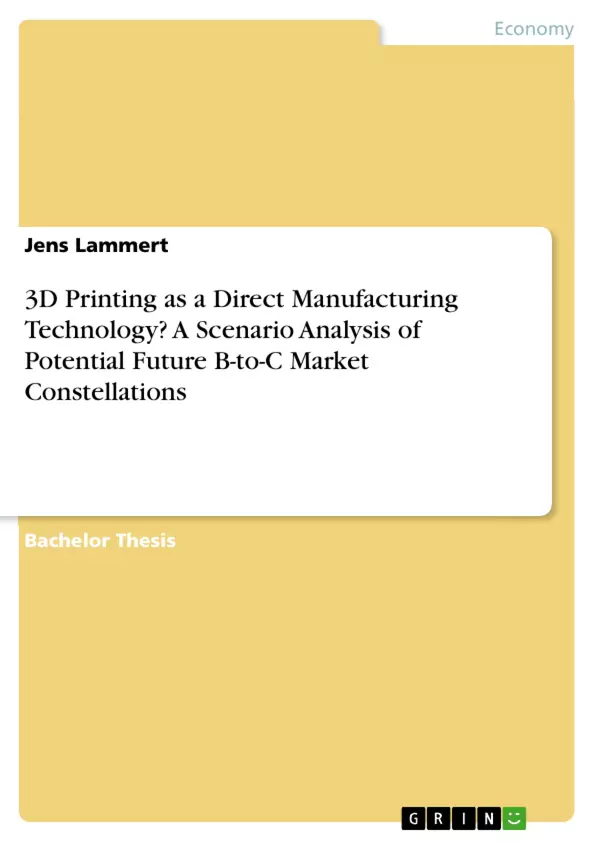3D printing technology recently receives much attention in mass media. While it is sometimes entitled as a technology that can bring a third industrial revolution it is not to deny that it will have huge influence on traditional manufacturing. Furthermore this technology comes along with a huge disruptive character since it nowadays demonstrates its potential for the future of consumers.
The dissemination of personal 3D printers and further 3D printing technologies involves a variety of opportunities and challenges. This thesis analyses the implications of 3D printing technologies on the B-to-C market focusing on possible future market constellations and conflict situations using the instrument of scenario technique in order to think ahead the future of the depicted area.
Inhaltsverzeichnis (Table of Contents)
- Introduction
- Theoretical Framework
- Fundamental Fabrication Processes
- 3D Printing
- Development Process
- Additive Manufacturing Technologies
- 3D Print with Powder
- SLS
- SLM
- EBM
- FDM
- Laser Cladding
- MJM
- SL
- PolyJet
- LOM
- FTI
- DLP
- Summary
- Scenario Technique
- Definition
- Origin
- The Scenario Funnel
- Scenario Analysis Procedure
- Scenario Preparation
- Scenario Field Analysis
- Scenario Prognostic
- Scenario Development
- Scenario Transfer
- Execution of the Scenario Analysis
- Scenario Preparation
- Scenario Field Analysis
- Direct Influence Analysis
- Relevance Analysis
- Selection of Key Factors
- Scenario Prognostic
- Price Model
- Use Time of Objects
- Surface Quality
- Willingness to go with new Technology
- Material Strength
- Intellectual Property
- Part Complexity
- Multi-Material-Processing
- Process Cost
- New Materials
- Material Costs
- Recycling
- Energy Use
- Speed
- Quality Assurance System
Zielsetzung und Themenschwerpunkte (Objectives and Key Themes)
This thesis aims to analyze the implications of 3D printing technologies on the B-to-C market, specifically exploring potential future market constellations and conflict situations. Utilizing the scenario technique, the study looks forward to the future of this field, considering the transformative impact of 3D printing on traditional manufacturing.
- Disruptive potential of 3D printing technology for consumers.
- Opportunities and challenges associated with the dissemination of 3D printing technologies.
- Future market constellations in the B-to-C sector influenced by 3D printing.
- Conflict situations arising from the integration of 3D printing in the B-to-C market.
- The use of scenario technique to anticipate and analyze potential future scenarios.
Zusammenfassung der Kapitel (Chapter Summaries)
- Introduction: This chapter sets the stage by introducing the topic of 3D printing technology and its potential impact on the B-to-C market. It highlights the significance of understanding potential future market constellations and conflict situations in this context.
- Theoretical Framework: This chapter provides a comprehensive overview of 3D printing technology, including fundamental fabrication processes, development processes, and various additive manufacturing technologies. It also introduces the concept of scenario technique, defining its purpose and outlining its key components and phases.
- Execution of the Scenario Analysis: This chapter delves into the practical application of scenario technique to analyze the future of 3D printing in the B-to-C market. It outlines the preparation phase, explores the field analysis through influence and relevance analysis, and dives into the scenario prognostic, examining key factors like price model, use time of objects, surface quality, and more.
Schlüsselwörter (Keywords)
The main focus of this thesis revolves around the influence of 3D printing technology on the B-to-C market. Key terms and concepts include additive manufacturing, scenario analysis, future market constellations, conflict situations, and disruptive potential. The study utilizes scenario technique to explore potential future scenarios, taking into account factors such as price, material strength, and the willingness of consumers to adopt new technologies.
- Quote paper
- Jens Lammert (Author), 2015, 3D Printing as a Direct Manufacturing Technology? A Scenario Analysis of Potential Future B-to-C Market Constellations, Munich, GRIN Verlag, https://www.grin.com/document/315782



